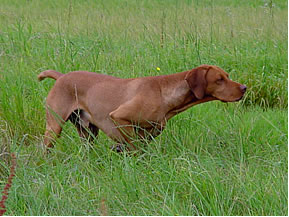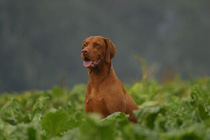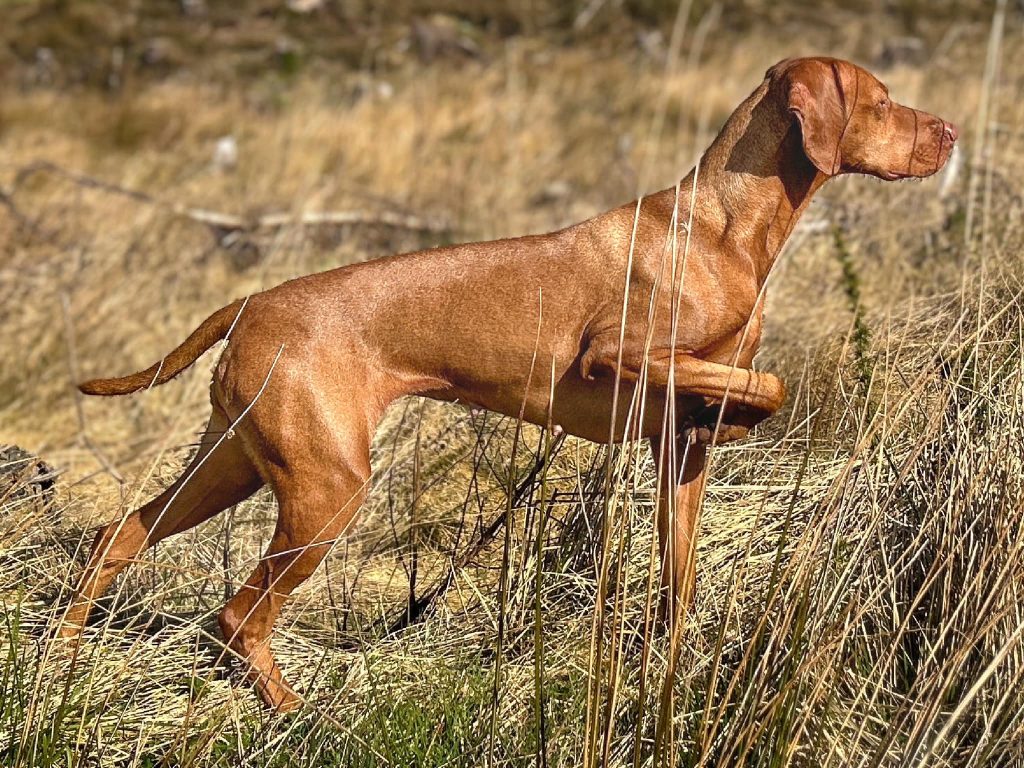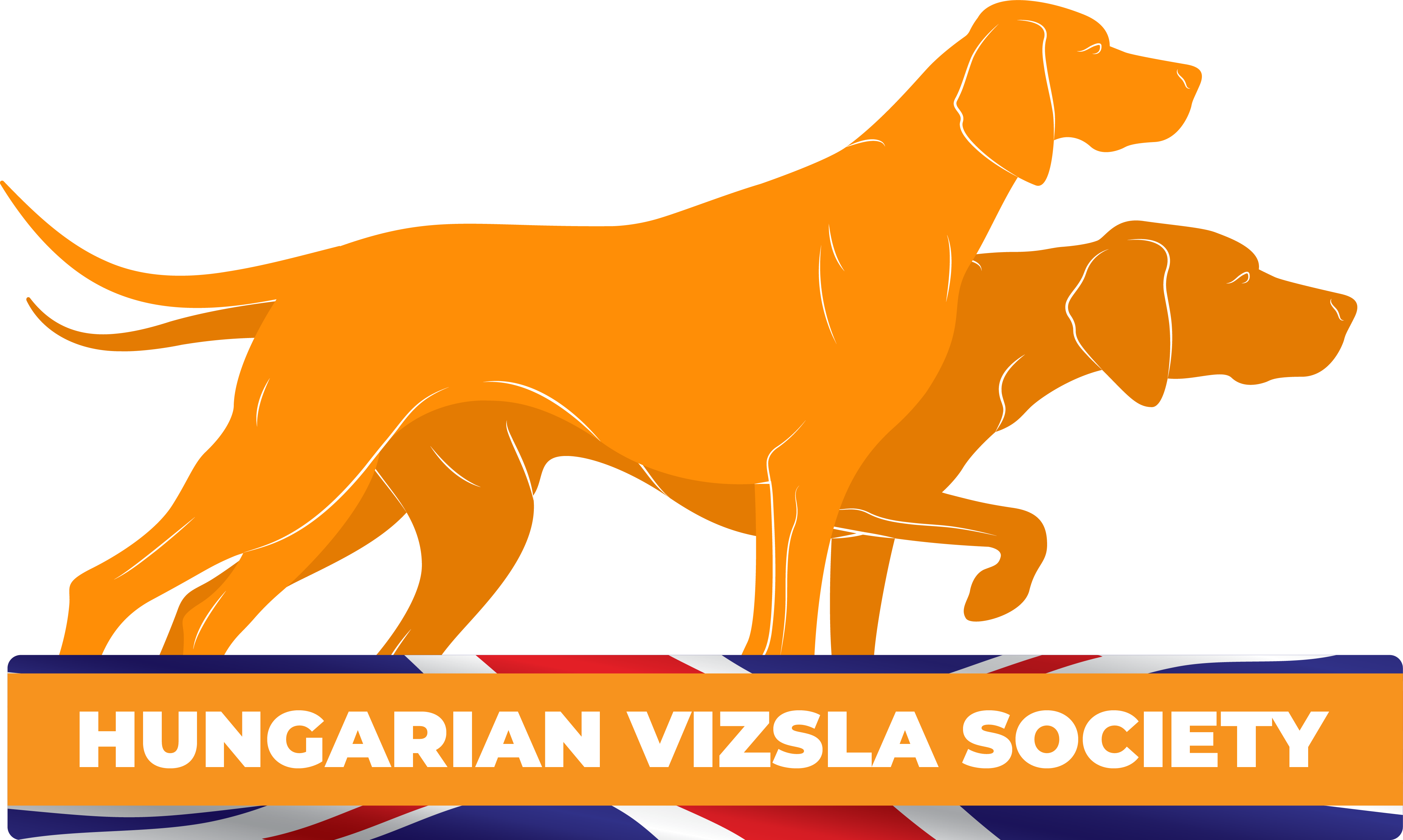HISTORY of the vizsla
The Vizsla belongs in dogdom’s aristocracy; he shows it in dignified bearing and proves it in recorded history. While the Vizsla is new to the Western World it is perhaps the oldest bred of the great European Vorstehund group of shorthaired pointing and retrieving dogs. The Vizsla achieved recognition as a breed centuries ago. However, the breed was never popularized in an American sense, but was rather restricted to the nobility. There is a long though unheralded history behind this unusual breed. – Primitive carvings in stone in the Carpathian regions – estimated 1,000 years old – show the Magyar hunter, his falcon and his Vizsla.
The Magyar Vizslas (Hungarian Pointers) honour their nomadic masters who roamed the Carpathian plains and valleys ten centuries ago. Herdsmen and hunters, these early Hungarians began the development of companion-hunting dogs to find, point, and retrieve native game, and to tract (sic) wounded large game. Successive generations continued the development of the breed and by the Thirteenth Century the beautiful golden Vizsla was a distinct breed, recognized and prized as a companion-field dog.



The word Vizsla, according to the Hungarian Etymological dictionary by G. Bordi, is documented first in the writings in the year 1350 as the name of a village on the Danube indicating that Vizslas may have been found in its environment. With the meaning “dog” it is documented in the Berstence Glossary compiled toward the end of the 14th Century. It is supposed to have come from the oldest layer of the Hungarian language, from a root -Vis- which means “to search.”
Credit for revealing the Vizsla’s claim to ancient and honorable lineage is due to the former Secretary of the Hungarian Kennel Club, who may well be one of the last living experts on the breed, and fortunately is now in this country. Prior to the occupation of Hungary by the Russians during World War II, the Hungarian Kennel Club began a search of family records and heirlooms for documentary proof on the history of the Vizsla. A priceless collection of evidence was compiled. Private documents, drawings, paintings, and sculpture confirmed the Vizsla’s existence in the 10th Century. Its history throughout the Middle Ages is confirmed in letters written in the 15th and 16th Centuries now in the National Archives in Hungary.
The golden Vizsla was the favorite companion dog of the early barons and warlords and, with the evolution of the nobility and large landowners, the breed was preserved in its purity through the centuries. There is little doubt that its ancestors were the hunting dogs of the various Asiatic tribes that invaded the lands of Central Europe until the 10th Century. The Vizsla presents several specific breed-marks, apart from the characteristic rusty-gold coat, that have never been found in any other variety of pointer. The Vizsla was an established and recorded breed at least 300 years before the Nobles of the Courts of Weimar set out to develop the Weimaraner around the year 1810, or before the first English Pointers were introduced into the Hungarian Kingdom in the year 1880.
Throughout the ages the Vizsla has been known as a “Gift of Kings” and breedings were restricted to the Nobility of the Greater Hungarian Kingdom, which covered Hungary and Czechoslovakia prior to World War I. To receive a “Royal Golden Vizsla” was an honor bestowed to only a very select few, such as the Queens of Italy and Spain, and Princess Iolanda di Savia, daughter of the King of Italy. The Vizsla bears the official title of the “National Pointer of Hungary” and the breed is especially protected by the Magyar Ebtenycstok Orsagos Egyesulete, whose purpose is to maintain the high standards of the breed.
The Vizsla is a rather privileged canine and holds a very high place in Hungarian sporting circles and is not expected to sleep outside at the finish of its day of work. The Vizsla always lived with the family, and was as much a part of the family as the children. It has been said that the Vizsla must live with the family if the family is to benefit (deserve) the loyalty and affection the Vizsla has to bestow. This breed has an exceptionally good disposition, is very affectionate, and instinctively fond of children. They are an apartment-sized family hunting dog.

The Vizsla is striking in appearance and never fails to attract attention. They have a very beautiful and distinctive shorthaired rusty-gold coat as well as a dignified and aristocratic bearing which sets them apart. They present the picture of versatile aristocrat, well balanced and with a look of intelligence and animation; a dog of great driving power, stamina, rugged constitution, in which the desire to hunt and the well-defined pointing and retrieving instincts are deeply ingrained. They have extremely high intelligence potentials and are exceedingly tractable and willing to obey whenever they understand. They have a rare adaptability to new conditions.
The Vizsla is a robust animal of considerate skill at its work, a shade taller and some pounds heavier than the English Pointer, and has a dominant natural instinct to point and retrieve. They are medium-sized, males generally weigh from 45 to 57 pounds; females about 10 pounds less. Height at the withers is generally from 19 ½ to 23 inches. The head is fine featured and aristocratic. The color of the iris of the eye should correspond to the lighter or darker hue of the coat. Picture left: Corinna Hansfords, Sh Ch Hawkpoint Peregrine (Tilly) © Copyright Corinna Hansford.
The ears are carried pendant, wide at the base and rather low set. Legs are straight, slender but well muscled. The feet are cat-like rather than hare footed. The carriage is deliberate. In action the Vizsla is extremely fast, yet its movement is so smooth and graceful as to appear effortless.
John Fogarassy-Wallner (famed Hungarian born artist) states as follows: “They had to take every hardship a human being could take; they had to stand the heat of our August sun; sit with us in a goose pit; swim icy waters after ducks; chase down wounded jack rabbits and retrieve them from half a mile away at times. Be absolutely obedient, and serve just one Master, so far as hunting was concerned. They were members of the family and we loved them but they had to have good manners and they had to behave”.
Comparisons are said to be rather “nefarious”. However, to properly classify this breed, it probably is essential to quote from Continental descriptions which compare the Vizsla with other pointing breeds. A European source states that the German Short hair, English and Vizsla pointers have excellent noses. The English pointer is extremely fast, the German the slowest and the Vizsla swift and not as wide-ranging as the English, but persistent on trail. The English is a poorer retriever while the German and Vizsla are excellent retrievers and the Vizsla more gentle mouthed. The Europeans also compare the Vizsla with the Weimaraner and state the Vizsla pointer is smaller, much faster, has more pointing instinct, is a more gentle mouthed retriever and is of a distinguished colour more suitable for use in the field.
To summarize, it appears that the Vizsla occupies a position between the extremely fast English pointer and the slower German short hair; combining some of the known excellencies of both breeds together with a very distinctive colour, type and dignified aristocratic bearing which sets him apart. The finely discriminating bird sense is deeply ingrained, in that the Vizsla’s home country is and has been for centuries, the low lying Danube Valley and brad Hungarian plain where the grey partridge thrive on the grain bin of Europe. The Vizsla breed has survived the Turkish Occupation, the Hungarian Civil Wars, World Wars I and II, and the Russian Occupation. The spread of the Vizsla to other parts of the world had changed little from the Middle Ages until 1945. As late as World War II the Vizsla enjoyed protection in selective breeding, as only the remnants of the aristocracy and the large estate owners were permitted by custom to breed.
